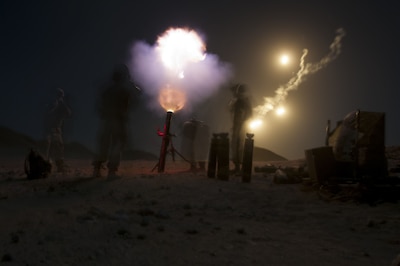By Army Sgt. David Nye U.S. Army Central
THUMRAIT, Oman, Feb. 2, 2018 — Surrounded by clear blue
skies and bright orange sand, Omani and U.S. forces conducted a simulated
assault here against dozens of enemy fighters, Jan. 31, in the culminating
event of Inferno Creek 18, a three-week training exercise conducted by the U.S.
and Omani armies.
The joint exercise allowed multiple elements of the
militaries to practice working together with the countries each contributing
scouts, mortars, infantry, engineers, and other elements that worked hand in
hand to complete their task: an assault on a simulated enemy compound followed
by a hasty defense against an armored enemy counterattack.
The success of the training mission relied on seeds planted
three weeks earlier, when leaders met to work through the military
decision-making process, or MDMP, according to Army Lt. Col. Jonathan M. Genge,
the U.S. task force commander for the exercise.
“It’s been great since day one, the Omanis coming in right
on time, every day, for MDMP, energetic, ready to tackle the task of the day,”
he said. “They’ve come in with their experiences [and] we’ve learned from that
as well. They took the lead in a lot of things with MDMP as well as [course of
action] development, the wargaming.”
New Challenges, Experiences
For the grunts on the ground, working with the Omanis
presented new challenges but allowed for great experiences.
“I feel pretty excited about it, because I’m working with
someone from an entirely different country,” said Army Pfc. Tyiamarte J. Linley
Jr., a mortarman with Headquarters and Headquarters Company, 1st Battalion,
35th Armored Regiment. “New language, new culture, new everything, and it’s
just fascinating, just learning more about a different country, a different
person, completely.”
The first elements hitting the objective were the scouts.
Omani vehicles dropped off U.S. forces near their planned observation posts and
most of the Americans dismounted to go on foot the last few hundred meters to
observe the battlefield. A few of the Americans went with the Omani vehicles,
which acted as mobile weapon platforms during the fight.
“At first, before the maneuver force gets to the objective,
we will be observing the objective area, identifying key personnel, key weapon
systems, any obstacles that could hinder their movement up to the objective,”
said Army Cpl. Jacob Kehler, the sniper team noncommissioned officer for the
exercise. “Once they get up to 100 meters or so, right before their assault on
the objective, we’ll transition up north to where we’re expecting an enemy
armored reconnaissance unit.”
As the maneuver force, made up primarily of Omani and U.S.
infantry and engineers, made its way up, the scouts and infantry automatic
weapons teams laid down a base of fire. With multiple teams from two armies
fighting at once, coordination was a challenge.
“It really tests our preparedness and our rehearsals,”
Kehler said, “to be able to coordinate between different units, us being scouts
and the infantry and the added personnel of the Omanis. So the coordination
between all units really has to be on point, it really tests how well you can
conduct everything going on, how proficient you are at communication between
the units.”
An engineer team with personnel from each force breached the
wire protecting the target compound with Bangalore torpedoes, explosive tubes
made for clearing obstacles, before the U.S. and Omani infantry squads poured
through the gap created by the detonation. Finally, an Omani rocket-propelled
grenade team destroyed a simulated T-72 tank that was attempting to take back
the compound.
Developing Combined Force Skills
While the exercise was complex, junior leaders emphasized to
their soldiers the importance of learning to work with other forces.
“We were up in Iraq for a couple weeks back in November,”
Kehler said. “And, when we were up there, there were British forces, Danish
forces and then French forces. So Americans aren’t the only people in these
combat zones right now. So being able to communicate even between those is very
key to not having any fratricide, being able to work smoothly, and contributing
to the combined effort is very important.”
Genge, the task force commander, agreed and praised the
value of the exercise for reinforcing and building partnerships. He also
expressed a hope that, while 2018 was the largest iteration of the annual
exercise yet, it would grow even larger.
“Inferno Creek 2018 is an opportunity for the U.S. and our
partner, the Omanis, to bridge a gap and build a relationship here in the
Middle East and to develop ourselves at the company and tactical level and now
make our way from the lower levels, the individual, all the way up to the
battalion and, looking to the future, maybe make our way up to the brigade
level and higher with not only just the maneuver but maybe a command post
exercise,” Genge said.








No comments:
Post a Comment